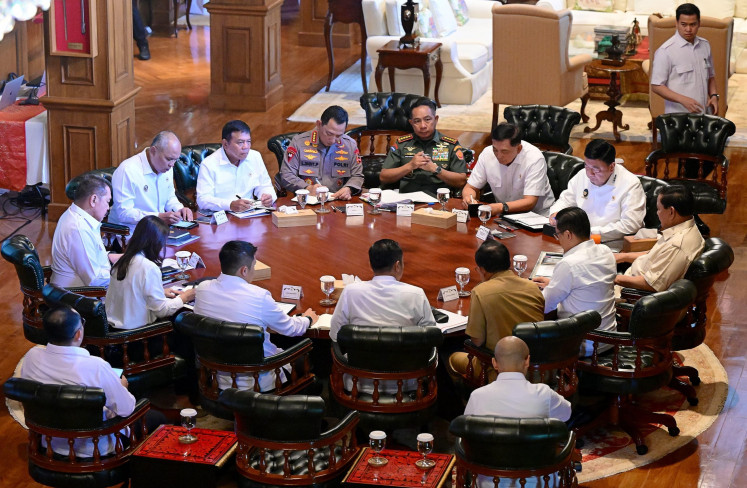Popular Reads
Top Results
Can't find what you're looking for?
View all search resultsPopular Reads
Top Results
Can't find what you're looking for?
View all search resultsIn Wonosari, a tea dance to welcome the rainy season
Dance fever: Women take to the field to perform during the Gumebyar Hametik Teh festival, or Jubilant Tea Harvest, at the Wonosari Tea and Agro-tourism Estates in Singosari in Malang, East Java
Change text size
Gift Premium Articles
to Anyone
D
span class="caption">Dance fever: Women take to the field to perform during the Gumebyar Hametik Teh festival, or Jubilant Tea Harvest, at the Wonosari Tea and Agro-tourism Estates in Singosari in Malang, East Java. (Nedi Putra AW)
Three horses passed bearing men dressed as traditional Javanese noblemen. The riders bore fruits, vegetables and tumpeng rice cones of thanksgiving.
Behind them, about 40 women dancers ' clad in green-and-yellow kebaya, farmer's hats and carrying the baskets used by tea leaf pickers ' followed in procession.
In front was a man called Sang Pemangku (The Guardian), clad in a beskap, or Javanese short jacket, who sat by incense burners to pray. When he finished, the women began to dance again, accompanied by a gamelan orchestra.
Carrying their baskets, the women performed a dance in the tea fields, as if they were farmers busy with picking and harvesting.
The activity was part of a festival called Gumebyar Hametik Teh, or the Jubilant Tea Harvest, at the Wonosari Tea and Agro-tourism Estates in Singosari in Malang, East Java.
'For the agro sector like tea plantations, the rainy season is very much anticipated, because it constitutes a blessing to us,' said RM Gandi, Wonosari Agro-tourism Manager, during the ceremony on Nov. 16.
It was the first time the estate staged the event, which Gandi said was held to thank God in hopes for bigger yields and to motivate workers.
The dance depicted the attention shown by the estate's owners, represented by the nobles, to the common people, in particular the women who comprise the majority of field hands.
The dancers were estate workers and local residents, while Gandi was one of the noblemen.
November is when tea leaves start growing after the season ends, Gandi says. 'Young shoots from November onward will produce the best quality tea, with a higher sale price.'
Following the dance, people joined a traditional tea tasting event called a nyeruput teh, devouring more-than-1,200 cups that were served in less than 10 minutes.
According to Gandi, the estate makes black tea processed by the CTC (cutting, tearing, curling) standard, derived from tea shoots and leaves harvested from plants grown at an elevation between 950 and 1,250 meters.
The estate, which makes dry tea powder for consumption and export, expects to have its next batch of top quality tea ready for auction by early 2015.
'Nyeruput teh is actually also part of the quality control by several panelists. Tea is a specific commodity of a hygroscopic nature. It's prone to contamination,' Gandi said.
The process usually uses two spoons: one to scoop tea hot from the cup and a second spoon for actually tasting. For the ceremony, however, spoons were replaced by small cups.
'As November 28 is Malang regency's 1,254th anniversary. This time the number of cups prepared for sipping is the same as the age of the regency,' Gandi said.
The inaugural tea dance and sipping event is part of the regency's tourism programs to welcome the rainy season. There are also plans to distribute equipment to make 1,254 biopores, or specially constructed holes to promote the absorption of surface water by the ground to reduce floods, landslides and the loss of trace elements.
'More importantly, this ritual serves as a means of popularization of tea drinking in society,' he indicated. The estate, covering 700 hectares and employing around 600 workers, can harvest up to 20 tons of wet tea leaves a day ' 25 tons in the rainy season ' yielding between three and four tons of dry tea after processing.
Of the total, 90 percent is exported to the US, the Netherlands, Britain and the Middle East, leaving only 10 percent for domestic processing.
'Indonesia's annual tea consumption is only 250 grams per capita, far lower than India's annual rate of 5 kilograms,' he said.
Indonesia is the fifth-largest tea producer, after Sri Lanka, India, Kenya and China. Low tea consumption in Indonesia is also due to the local habits in tea drinking. 'In tea-drinking countries, the tea is discarded after brewing to maintain the flavor of the drink. In Indonesia, dregs are used more than once,' he added.
The estate's historical records shows that the first tea plants were brought to Indonesia by a Dutchman, Dr. Andreas Cleyer, for decoration and were later grown for plantations by a man named Jacobson in 1828.
Tea was first planted in Wonosari in 1910 by a Dutch company, NV Cultur Maatschappy. The Wonosari Tea Estate is one of several tea plantations in East Java. Others include Gunung Gambir in Jember, Kertowono in Lumajang and Bantaran in Blitar.
The Wonosari estate, which sits at the foot of Mount Arjuno, has been a unit of the PTPN XII state owned estate company since 1996. It has since been developed into a tourist destination offering visitors accommodations, recreation and sports facilities.











